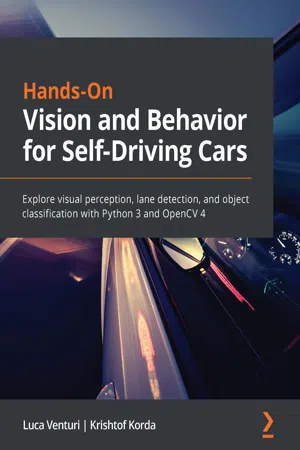
Hands-On Vision and Behavior for Self-Driving Cars
Explore visual perception, lane detection, and object classification with Python 3 and OpenCV 4
- 374 pages
- English
- ePUB (mobile friendly)
- Available on iOS & Android
Hands-On Vision and Behavior for Self-Driving Cars
Explore visual perception, lane detection, and object classification with Python 3 and OpenCV 4
About this book
A practical guide to learning visual perception for self-driving cars for computer vision and autonomous system engineers
Key Features
- Explore the building blocks of the visual perception system in self-driving cars
- Identify objects and lanes to define the boundary of driving surfaces using open-source tools like OpenCV and Python
- Improve the object detection and classification capabilities of systems with the help of neural networks
Book Description
The visual perception capabilities of a self-driving car are powered by computer vision. The work relating to self-driving cars can be broadly classified into three components - robotics, computer vision, and machine learning. This book provides existing computer vision engineers and developers with the unique opportunity to be associated with this booming field.
You will learn about computer vision, deep learning, and depth perception applied to driverless cars. The book provides a structured and thorough introduction, as making a real self-driving car is a huge cross-functional effort. As you progress, you will cover relevant cases with working code, before going on to understand how to use OpenCV, TensorFlow and Keras to analyze video streaming from car cameras. Later, you will learn how to interpret and make the most of lidars (light detection and ranging) to identify obstacles and localize your position. You'll even be able to tackle core challenges in self-driving cars such as finding lanes, detecting pedestrian and crossing lights, performing semantic segmentation, and writing a PID controller.
By the end of this book, you'll be equipped with the skills you need to write code for a self-driving car running in a driverless car simulator, and be able to tackle various challenges faced by autonomous car engineers.
What you will learn
- Understand how to perform camera calibration
- Become well-versed with how lane detection works in self-driving cars using OpenCV
- Explore behavioral cloning by self-driving in a video-game simulator
- Get to grips with using lidars
- Discover how to configure the controls for autonomous vehicles
- Use object detection and semantic segmentation to locate lanes, cars, and pedestrians
- Write a PID controller to control a self-driving car running in a simulator
Who this book is for
This book is for software engineers who are interested in learning about technologies that drive the autonomous car revolution. Although basic knowledge of computer vision and Python programming is required, prior knowledge of advanced deep learning and how to use sensors (lidar) is not needed.
Frequently asked questions
- Essential is ideal for learners and professionals who enjoy exploring a wide range of subjects. Access the Essential Library with 800,000+ trusted titles and best-sellers across business, personal growth, and the humanities. Includes unlimited reading time and Standard Read Aloud voice.
- Complete: Perfect for advanced learners and researchers needing full, unrestricted access. Unlock 1.4M+ books across hundreds of subjects, including academic and specialized titles. The Complete Plan also includes advanced features like Premium Read Aloud and Research Assistant.
Please note we cannot support devices running on iOS 13 and Android 7 or earlier. Learn more about using the app.
Information
Table of contents
- Hands-On Vision and Behavior for Self-Driving Cars
- Why subscribe?
- Preface
- Section 1: OpenCV and Sensors and Signals
- Chapter 1: OpenCV Basics and Camera Calibration
- Chapter 2: Understanding and Working with Signals
- Chapter 3: Lane Detection
- Section 2: Improving How the Self-Driving Car Works with Deep Learning and Neural Networks
- Chapter 4: Deep Learning with Neural Networks
- Chapter 5: Deep Learning Workflow
- Chapter 6: Improving Your Neural Network
- Chapter 7: Detecting Pedestrians and Traffic Lights
- Chapter 8: Behavioral Cloning
- Chapter 9: Semantic Segmentation
- Section 3: Mapping and Controls
- Chapter 10: Steering, Throttle, and Brake Control
- Chapter 11: Mapping Our Environments
- Assessments
- Other Books You May Enjoy